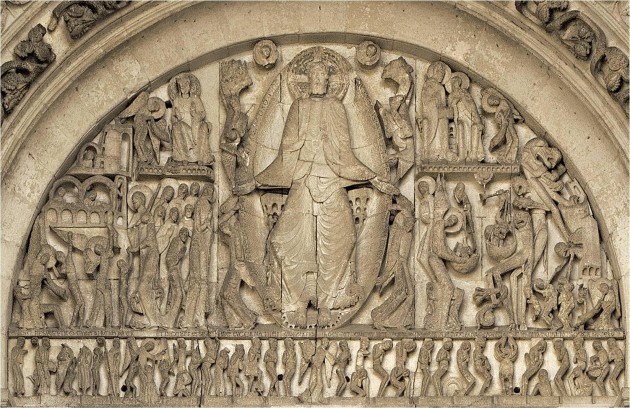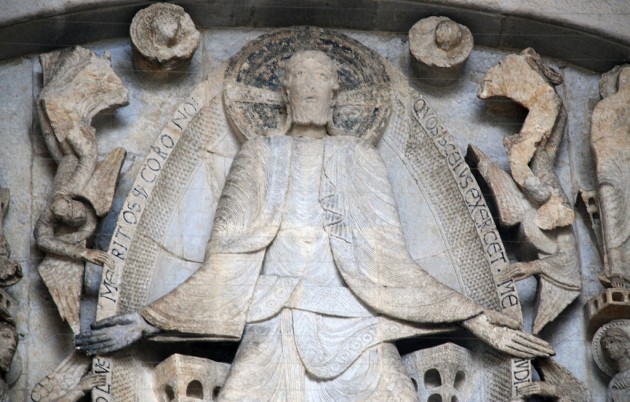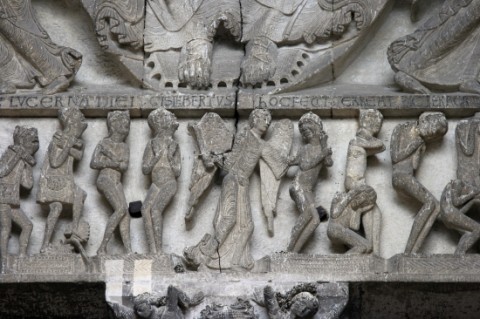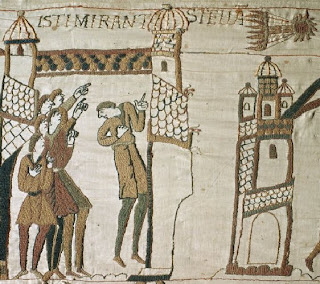Saturday, December 2nd, 2017
Plaster Cover-Up and the “Last Judgment” at Autun Cathedral

Tympanum depicting the “Last Judgment” from the Saint-Lazare Cathedral, Autun, France. c. 1120-1130 or c. 1130-1145. Base of tympanum is approximately 21′ in length
Earlier this week, I was discussing the “Last Judgment” tympanum at the Cathedral of Autun with my students. I pointed out some details of the bottom-most register (such as this one), and explained that the dead are rising out of their sarcophagi, waiting to be judged by Christ at his Second Coming. These references to resurrection and life after death is especially appropriate on this church, since the Romanesque church was built to house the bones of Saint Lazarus, the man whom Christ rose from the dead.
Then one of my students asked where Saint Lazarus’ bones were located in the church. Since I haven’t visited this church in person, I said that I would look into that question and let him know. In the process, I discovered some very interesting history: the bones of Saint-Lazarue don’t exist anymore because they intentionally were destroyed. For centuries, beginning around 1170-1180, the bones of Saint Lazarus were located in a tomb in the choir area (closer to the east side of the church, in front of the the apse). However, the tomb and bones they were destroyed during the French Revolution (1789-1799) by hostile revolutionaries.
Such destruction of art was not uncommon during the French Revolution, due to the anti-religious and anti-monarchical sentiment that existed at the time. Some French revolutionaries wanted to disassociate themselves and the rising French nation from the traditional past, and the government even endorsed some of this destruction. In fact, other sculptures at the Autun Cathedral were also destroyed by revolutionaries, but luckily the Last Judgment tympanum was preserved through an ironic twist of fate. Around 1766, before the revolution, the tympanum was covered with plaster as part of a remodeling effort to remove traces of the medieval period within the church. In order to achieve a smooth surface of the new plaster covering, Christ’s head was cut off. The head was discovered in the 20th century, authenticated, and restored to its original position in 1948 (although a visible break in the neck is perceptible; see detail below).1

Detail of Christ from the “Last Judgment” tympanum at Autun Cathedral, c. 1120-1130 or c. 1130-1140. Image courtesy Steven Zucker via Flickr (https://creativecommons.org/licenses/by-nc-sa/2.0/; image is unaltered)
So, ironically, the Last Judgment tympanum was preserved because the clergymen didn’t like the medieval style! Because it was covered up with plaster about two decades before the French Revolution, the tympanum was not destroyed and was only rediscovered when the plaster was removed in 1837. What luck this work of art exists today!
1 Paul L. Cioffi, “Saint-Lazare Tympanum and Tumeau, West portal,” Georgetown University Library, https://repository.library.georgetown.edu/handle/10822/554259, accessed 2 December 2017. See also Linda Seidel, “Legends in Limestone: Lazarus, Giselbertus, and the Cathedral of Autun” (Chicago: University of Chicago Press, 1999), 26.






